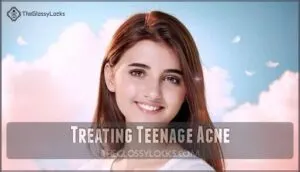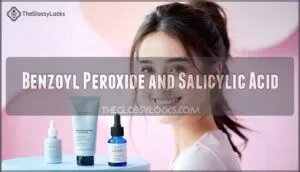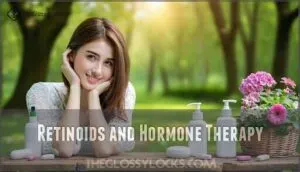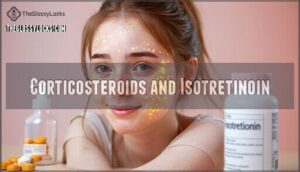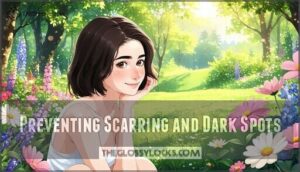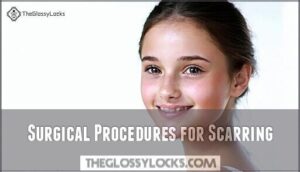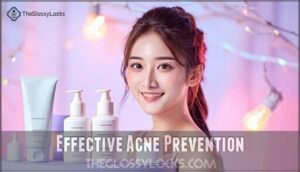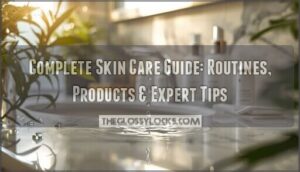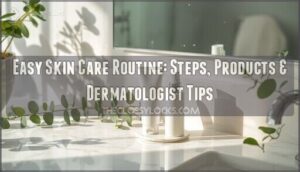This site is supported by our readers. We may earn a commission, at no cost to you, if you purchase through links.
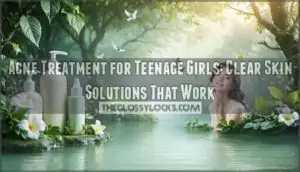
You’re not alone—nearly 85% of teens deal with breakouts.
The good news is that effective acne treatment for teenage girls combines proven ingredients like benzoyl peroxide and salicylic acid with consistent skincare habits.
Start with gentle cleansing twice daily, then introduce targeted treatments gradually to avoid irritation.
Over-the-counter options work for mild acne, while persistent breakouts may need prescription help.
Remember, clear skin takes time—most treatments show results after 6-12 weeks of consistent use.
The secret lies in understanding which approach matches your specific skin type.
Table Of Contents
- Key Takeaways
- Acne Causes Explained
- Treating Teenage Acne
- Acne Treatment Options
- Managing Acne Scars
- Effective Acne Prevention
- Frequently Asked Questions (FAQs)
- What is the best thing for teenage girl acne?
- What is the best treatment for acne in girls?
- What is the first line treatment for teenage acne?
- How do I help my daughter with her acne?
- Can acne affect my period or hormones?
- Is acne contagious between friends or family?
- How long until I see treatment results?
- Can makeup worsen my teenage acne?
- Should I pop or squeeze my pimples?
- Conclusion
Key Takeaways
- Start with gentle over-the-counter treatments – You’ll see the best results by combining benzoyl peroxide and salicylic acid in your daily routine, as these ingredients kill bacteria and unclog pores effectively.
- Be patient with your treatment timeline – You won’t see meaningful improvements for 6-12 weeks, so stick with your routine consistently rather than switching products every few days when you don’t see instant results.
- Don’t pick or squeeze your pimples – You’ll worsen inflammation and create permanent scarring by pushing bacteria deeper into your skin, so resist the urge and let treatments do their work.
- Consider prescription help for persistent breakouts – If over-the-counter products aren’t working after 8 weeks, you should consult a dermatologist who can prescribe retinoids, antibiotics, or hormone therapy for more stubborn acne.
Acne Causes Explained
Understanding what causes your acne is the first step toward finding treatments that actually work for your skin.
Your pores become clogged when sebum (natural skin oil), dead skin cells, and bacteria create the perfect storm for breakouts to develop.
Clogged Pores and Hair Follicles
Understanding clogged pores starts with knowing what’s happening beneath your skin’s surface.
Your hair follicles become plugged when sebum, dead skin cells, and keratinocytes stick together inside the pore opening.
When pores get blocked, it’s like traffic jam under your skin—nothing moves smoothly.
This pore blockage prevents normal shedding and creates the perfect environment for acne development.
Proper follicle care through gentle skin exfoliation helps maintain clear skin pores and effective sebum control.
Regular maintenance of skin health is essential to prevent issues related to hair growth problems.
Sebum and Dead Skin Cells
Your skin’s oil glands work overtime during your teenage years, producing excess sebum that mixes with dead skin cells.
This combination creates the perfect storm for clogged pores and hormonal acne in teenage girls.
Here’s what happens inside your follicles:
- Sebum Production increases dramatically due to hormonal changes
- Dead Skin cells don’t shed properly, creating cell blockage
- Pore Clogging occurs when oil and cells stick together, compromising follicle health
Bacteria Growth and Inflammation
Bacteria love blocked pores—they’re like cozy apartments for unwanted guests.
Think of acne bacteria as uninvited houseguests who won’t leave your pores alone.
When Pore Blockage occurs, normal skin bacteria multiply rapidly, creating Bacterial Proliferation within follicles.
This overgrowth triggers your body’s Inflammatory Response, causing the telltale redness, swelling, and tenderness of Follicle Infection.
The resulting Skin Irritation makes acne treatment for teenage girls essential, especially for hormonal acne prevention.
Treating Teenage Acne
When you’re dealing with teenage acne, you’ve got more treatment options than ever before to help clear your skin effectively.
From gentle topical treatments to prescription medications, the right combination can make a real difference in how your skin looks and feels, with complete concepts and treatment options being key to success.
Topical Creams and Gels
Topical acne treatment for teenage girls starts with effective gel applications and cream benefits.
Benzoyl peroxide reduces bacteria by 35-65% within eight weeks, while salicylic acid provides gentle skin soothing for sensitive areas.
Spot treatments target individual breakouts without over-drying surrounding skin.
Product reviews consistently show combination therapies work better than single ingredients, offering clearer results for persistent acne.
Effective acne gel treatment often involves using products found through acne gel options, which can lead to clearer results.
Oral Medications and Antibiotics
When topical treatments aren’t enough, oral medications can be game-changers for moderate to severe acne.
These systemic approaches target inflammation and bacteria from within, offering hope when creams fall short.
- Oral antibiotics (doxycycline, minocycline) reduce inflammatory lesions by 55-80% after 3-4 months but require monitoring for antibiotic resistance
- Hormone therapy through birth control pills helps 30-60% of girls with menstrual cycle-related breakouts by balancing androgens
- Isotretinoin effects include 70-90% clearance rates for severe cases, though strict monitoring prevents serious side effects
- Antibiotic dosage typically lasts 3-6 months maximum to minimize resistance development and preserve treatment effectiveness
Understanding acne treatment methods is essential for determining the best course of action for each individual case.
Lifestyle Changes and Skincare
Beyond medications, your daily habits substantially impact your skin’s health.
A consistent skincare routine with gentle cleansers prevents pore blockage, while a healthy diet low in dairy and processed foods reduces inflammation.
Managing stress through exercise or meditation helps balance hormones that trigger breakouts.
Prioritize seven to nine hours of sleep nightly, as poor sleep patterns worsen acne.
Stay hydrated with plenty of water to flush toxins and maintain skin elasticity for effective acne prevention tips.
Using the right acne face wash products is essential for a clear skin routine.
Acne Treatment Options
Finding the right acne treatment can feel overwhelming, but you’ve got effective options that target the root causes of breakouts.
From over-the-counter solutions to prescription medications, these treatments work by reducing oil production, unclogging pores, and fighting bacteria that cause inflammation.
Benzoyl Peroxide and Salicylic Acid
Over-the-counter powerhouses like benzoyl peroxide and salicylic acid offer proven acne reduction for teenage girl skincare routines.
Benzoyl benefits include killing bacteria and reducing sebum production by up to 50% within 8-12 weeks.
Salicylic effects focus on skin purification, breaking down blackheads and whiteheads while promoting pore minimization through gentle exfoliation of dead skin cells.
Understanding acne treatment methods is essential for developing an effective skincare plan.
Retinoids and Hormone Therapy
Retinoids frequently revolutionize acne treatment for teenage girls by accelerating skin renewal and preventing clogged pores.
These vitamin A derivatives offer powerful retinoid benefits, reducing inflammatory lesions by up to 64% within twelve weeks.
Meanwhile, hormone therapy targets hormonal acne through hormone regulation, addressing excess androgens that trigger breakouts.
Combined therapy options provide thorough acne prevention, making both treatments essential weapons against stubborn teenage skin challenges, utilizing complete concepts for effective treatment.
Corticosteroids and Isotretinoin
When acne inflammation becomes severe, corticosteroids offer quick relief through direct injection into painful nodules.
Isotretinoin, reserved for treatment-resistant cases, requires careful monitoring due to skin sensitivity concerns.
Your dermatologist will determine proper isotretinoin dosage based on your specific needs.
These powerful oral medications represent the strongest options in steroid therapy and teenage acne treatment.
Managing Acne Scars
Once you’ve treated your active acne, you’ll want to address any scars or dark spots left behind.
The good news is that most acne marks will fade naturally over time, and several proven treatments can speed up this process while preventing new scarring from forming.
Preventing Scarring and Dark Spots
Protecting your skin from future acne scarring starts with gentle care and smart choices.
Don’t pick, squeeze, or pop pimples – this damages skin tissue and increases your risk of permanent marks.
Key scar prevention strategies:
- Apply broad-spectrum SPF 30+ sunscreen daily to prevent hyperpigmentation
- Use gentle, non-comedogenic skincare products to avoid irritation
- Start acne treatment early to minimize inflammation and tissue damage
Early intervention with proper acne treatment for teenage girls substantially reduces acne scarring and dark spot formation.
Fading Existing Dark Spots
Dark spots from healed acne don’t have to be permanent reminders of your skin struggles.
Topical treatments containing hydroquinone, kojic acid, or vitamin C effectively target hyperpigmentation by blocking melanin production.
Spot treatment serums with niacinamide reduce inflammation while brightening affected areas.
Consistent skin brightening routines show results within 6-8 weeks.
For stubborn acne dark spots, dermatologists may recommend prescription-strength dark spot removal products that accelerate scar fading through gentle exfoliation.
Surgical Procedures for Scarring
When traditional acne treatments haven’t cleared your scars completely, surgical procedures offer hope.
Laser therapy targets deep acne scars with focused light energy, while chemical peels remove damaged skin layers.
Microneedling stimulates natural healing, and scar fillers smooth depressed areas.
Dermabrasion resurfaces skin for teenage girls seeking thorough acne treatment solutions, utilizing laser therapy as part of the process is not mentioned but dermabrasion is a method.
Effective Acne Prevention
You can prevent most breakouts by following a consistent skincare routine and making smart lifestyle choices.
The key is understanding what triggers acne in the first place—then you can take steps to stop those problems before they start, which involves complete concepts and smart decisions.
Proper Skincare and Hygiene
Building healthy habits starts with gentle Face Washing twice daily using lukewarm water and mild cleanser.
Your Daily Routine should include morning care that removes overnight oil buildup without over-scrubbing.
Skip harsh Skin Exfoliation—it irritates teenage skin care needs.
These simple Hygiene Tips form your foundation for effective acne prevention for teens and long-term skin health.
Understanding hormonal fluctuations is essential in developing a personalized skincare routine.
Diet and Nutrition for Acne
Your diet directly impacts acne and nutrition research proves it.
High glycemic index foods like white bread trigger breakouts, while omega benefits from fish reduce inflammation.
Identify your food triggers through elimination diets. Maintain nutrient balance with zinc and vitamin E.
Follow hydration tips—drink plenty of water daily. These acne prevention strategies for girls support skin health for teens naturally.
Understanding proper acne diet plans is essential for effective acne management.
Stress Management and Self-Care
While nutrition matters for your skin, stress can trigger hormonal fluctuations that worsen acne breakouts.
Managing stress through mindful meditation and relaxation techniques supports emotional balance and mental wellness. Your skin care routine for acne works better when you’re emotionally centered.
- Sleep like your skin depends on it – because it literally does, and those dark circles won’t hide the breakouts
- Practice deep breathing when acne flares spike your anxiety – your skin reflects your inner calm
- Create a self care ritual that makes you feel worthy – acne and self-esteem battles need gentle victories
- Remember that stress management isn’t selfish – it’s essential medicine for both acne treatment for teenage girls and long-term mental wellness
Frequently Asked Questions (FAQs)
What is the best thing for teenage girl acne?
Despite believing you can’t avoid breakouts, you can control them effectively.
Start with gentle cleansing twice daily, then apply benzoyl peroxide or salicylic acid treatments.
Consider hormonal contraceptives for persistent cases.
What is the best treatment for acne in girls?
You’ll want to start with gentle topical treatments like benzoyl peroxide or salicylic acid cleansers. For persistent breakouts, combination therapy using retinoids with antibiotics often works best for teenage skin.
What is the first line treatment for teenage acne?
First-line treatment combines topical benzoyl peroxide with a retinoid like adapalene.
You’ll see results in 8-12 weeks with consistent use.
This duo tackles bacteria, unclogs pores, and prevents new breakouts effectively.
How do I help my daughter with her acne?
Seventy percent of teens experience acne, making it nearly universal during adolescence.
Start with gentle cleansers and over-the-counter benzoyl peroxide or salicylic acid products.
If these don’t help within 6-8 weeks, consult a dermatologist for prescription treatments like topical retinoids or oral medications.
Can acne affect my period or hormones?
Actually, it’s the reverse – your hormones can affect acne, not the other way around.
Hormonal fluctuations during your menstrual cycle can trigger breakouts, especially before your period when androgen levels spike and increase oil production.
Is acne contagious between friends or family?
No, acne isn’t contagious.
You can’t catch it from touching someone’s skin or sharing pillowcases.
Acne develops from your own blocked pores, excess oil, and bacteria already living on your skin—not from outside sources.
How long until I see treatment results?
While some notice changes within days, most teens see meaningful improvement after 6-12 weeks of consistent treatment. Your skin’s healing timeline depends on treatment type and severity—patience pays off.
Can makeup worsen my teenage acne?
Yes, makeup can worsen acne by clogging pores, especially oil-based products. Choose non-comedogenic, oil-free formulas and always remove makeup thoroughly before bed to prevent breakouts.
Should I pop or squeeze my pimples?
Ever wonder why dermatologists cringe when you squeeze pimples?
Don’t pop them! Squeezing pushes bacteria deeper into your skin, causing more inflammation and potential scarring.
Your hands carry germs that’ll make breakouts worse. Let professional treatments work instead.
Conclusion
Revolutionary breakthroughs in acne treatment for teenage girls have transformed what once seemed like an impossible battle into a manageable journey.
You’ve got powerful weapons at your disposal—from gentle cleansers to prescription medications—that can dramatically improve your skin’s appearance.
Remember, consistency beats perfection every time, and don’t expect overnight miracles, but trust the process.
With the right combination of treatments, proper skincare habits, and patience, you’ll achieve the clear, healthy skin you deserve.

